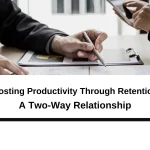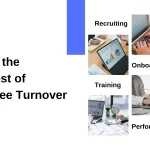
Every leader knows turnover is costly, but most underestimate just how much. You think of recruitment ads, headhunter fees, and time spent interviewing. Painful, yes, but manageable. Right? Unfortunately, the real cost of turnover goes much deeper than posting jobs and conducting interviews.
Replacing employees doesn’t just hurt your budget, it disrupts stability, slows innovation, and damages credibility with clients. And the numbers? They’re eye-opening. Deloitte estimates that the cost of losing a single employee can run from tens of thousands of dollars up to nearly twice their annual salary.
So, what is the cost of employee turnover really? And more importantly, what can you do to reduce it? Let’s dig in.
Globally, disengaged employees cost the economy $7 trillion in lost productivity every year. Four out of five people dread going to work. Beyond the human toll, this disengagement translates directly into high turnover rates, and that’s where the money drain begins.
People-related costs make up as much as 70% of total expenses in most companies. When employees leave, it’s not about HR scrambling; it’s managers, clients, and teams who feel the disruption.
And here’s the kicker: turnover breeds more turnover. The more departures you have, the more unstable the environment becomes, and the more others start looking for the exit.
When leaders calculate turnover, they usually think of the obvious: advertising the role, paying recruiters, or onboarding new hires. But those are just the direct costs. The indirect costs are often much higher, and far more damaging.
Consider the following three stages of financial impact:
By the time you add it all up, you’ve easily spent 1.5 to 2 times the employee’s annual salary.
The dollar figures are big, but the intangible costs may be even worse. Here are four hidden drains not to overlook:
If you’ve ever had clients raise an eyebrow at the revolving door on your team, you know how credibility loss can cost you more than money. It can cost you relationships.
Turnover isn’t just financial, it’s systemic. Every time someone leaves, it sends a signal to those who are left behind. Should they stay? Should they be polishing their LinkedIn profile?
If you’re familiar with the forming–storming–norming–performing model of group development, Bruce Tuckman’s description of the inevitable phases a team goes through, then you may wonder: when does a team with high employee turnover ever start performing?
The reality is that teams that never reach the “performing” stage of Bruce Tuckman’s group model spend their time stuck in forming and storming. The result: constant adjustment, little momentum, and even less trust.
A revolving door makes it nearly impossible to create a thriving, innovative environment. It’s not just the leavers who hurt you. It’s the people who stay but silently disengage.
The opposite of turnover is engagement, and the payoff is massive. According to Gallup, companies with highly engaged employees enjoy:
In other words, investing in engagement doesn’t just stop losses, it multiplies gains.
So how do you reduce the cost of employee turnover? Here are proven steps, grounded in both research and experience.
The single biggest driver of retention is the relationship with a direct manager. Not company perks. Not vision statements. Not onboarding. If employees feel supported and valued by their boss, they’re far more likely to stay.
A résumé can’t tell you if someone will collaborate well or stay engaged long term. Move beyond gut instinct and use structured assessments that measure interpersonal fit, engagement potential, and team compatibility.
One of the top reasons people leave is lack of opportunity. Even if promotions aren’t possible, offering training, mentoring, and skill development reinforces commitment to employees’ futures.
Glossy mission statements don’t matter if lived reality contradicts them. Employees can spot hypocrisy a mile away. Authenticity builds trust; empty rhetoric fuels cynicism and exits.
Humans are wired for connection. Foster collaboration, celebrate wins, and encourage growth. A sense of belonging makes employees more resilient, creative, and loyal.
Every organization pays for turnover, either proactively through engagement and retention strategies or reactively through constant rehiring, which is much higher. The only choice is which bill you’d rather pay.
If you want to see what turnover is costing you right now, run the formula:
Turnover Costs = FTE × Turnover Rate × Average Salary × 1.5
Then ask yourself: What could you do with that money instead? Invest in growth? Upgrade systems? Reward your best people so they don’t want to leave?
The real cost of employee turnover isn’t just about dollars lost. It’s about missed opportunities, strained relationships, and stalled growth. But the good news is that turnover is not inevitable.
By investing in smarter hiring, better leadership fit, and meaningful engagement, you can break the cycle. Instead of watching your best people walk out the door, you can create an environment where they choose to stay, grow, and thrive.
At the end of the day, turnover is expensive. Engagement is profitable. Which one will you choose to invest in?

Boosting Productivity Through Retention: A Two-Way Relationship Minal Joshi Jaeckli October 31, 2025 When leaders talk about productivity, the conversation almost always drifts toward tools,.

What Is the Real Cost of Employee Turnover? (And How to Reduce It) Minal Joshi Jaeckli October 28, 2025 Every leader knows turnover is costly,.

How Workplace Flexibility Boosts Employee Satisfaction and Reduces Turnover Minal Joshi Jaeckli October 25, 2025 Work has changed a lot in the past few years..